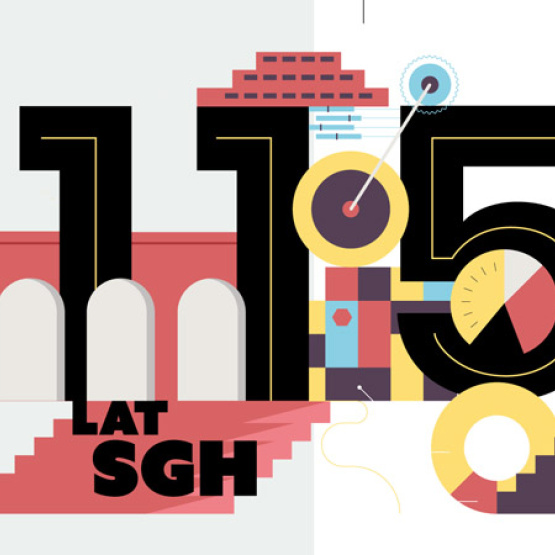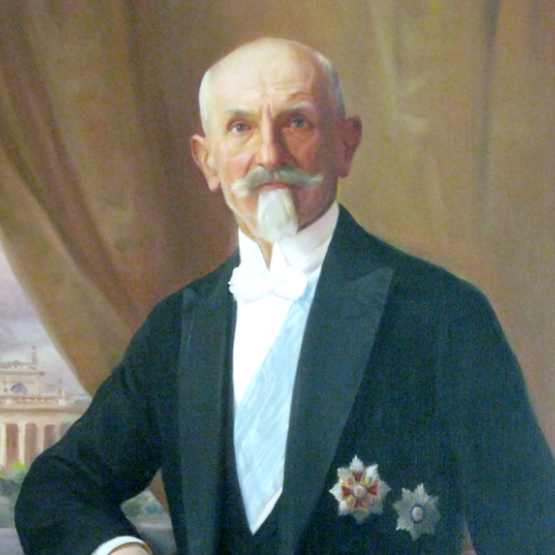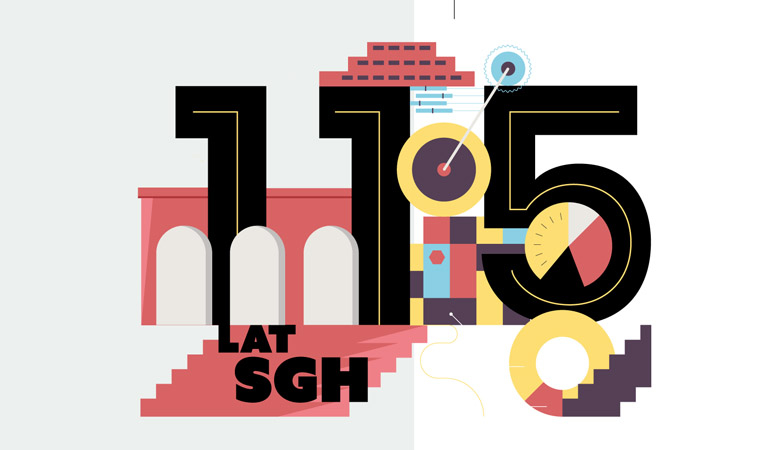
The History of SGH Warsaw School of Economics – Part III. Years of political and ideological pressure
The first post-war inauguration of the academic year of 1945/1946, which took place on 1 October 1945 in already reconstructed Building A, marked another chapter in the history of SGH Warsaw School of Economics. At first, nothing portended a stormy time. Students started their classes as per the curriculum. The curriculum of the academic year of 1945/1946 allowed for the Warsaw School of Economics being a single-faculty university arranged so that, by diploma date, the six-semester long studies will be split into Period 1 consisting of four semesters and uniform for all the students and Period 2 consisting of two semesters and varied with respect to the chosen field of study. Doctoral studies for candidates seeking to obtain the degree of doctor of economic sciences were supposed to last another two semesters. The fields of study in the third year were: general economics, business economics and public economics. In the first semester, the student would enrol in two foreign language courses completed by a mandatory exam after the third year of study.
In the first post-war academic year, the teaching staff consisted of forty-five employees, including such prominent researchers as Jan Drewnowski, Andrzej Grodek, Kazimierz Kasperski, Leon Koźmiński, Marian Kowalski, Edward Lipiński, Jerzy Loth, Julian Makowski, Stanisław Rączkowski, Bogdan Suchodolski, Stefan Szulc, Aleksy Wakar. The first rector was prof. Jerzy Loth.
In July 1946, a branch in Łódź was established to be later on transformed into the Higher School of Economics, and then into the Economic Faculty of the University of Lodz.
The university was engaged in scientific research. In the academic year of 1946/1947, the following research units were active: Political Economy, Commodity Trading Economics, Business Economics, Economic Geography, Statistics, Centrally Planned Economy, Economic Teacher Education, Study of Warsaw Economy and the Institute of Accounting.
Starting in 1947, pressure emerges from the Ministry of Education to saturate the transmitted knowledge with more ideological content. Special conferences presenting Marxist theories and the ongoing problems of the socialist economy were organised. Their participants included Włodzimierz Brus, Bronisław Minc, Czesław Nowiński. The reading list was expanded to include items from the classics of Marxism-Leninism and Soviet authors of that time. In March 1948, a decision was made to establish an economic university corresponding to the new political systemic conditions. Consequently, a decree of August 1949 was passed on nationalising SGH and transforming it into the Main School of Planning and Statistics (SGPiS). The tradition has it, SGH Senate accepted the information on university nationalisation in silence at its last meeting in the academic year of 1948/1949.

The construction of the Main Building in Aleja Niepodległości, dated 1954 r.
SGPiS – a tool of centrally planned economy
The decree of 1949 and the changes taking place in study curricula and well as in the composition of teaching and research staff gave rise to a gradual transformation of the university by people fulfilling party instructions who were not affiliated with the academic community.
The first rector of SGPiS was Czeslaw Nowiński who worked in the Department of Fundamentals of Marxism-Leninism and headed the Department of Dialectical Materialism. To complete the task of creating a new type of economic school, he obtained not only political support of PZPR – the Polish United Workers’ Party – but also ample funds to enable, for example, reconstruction of the Main Building on the side of Niepodległości Avenue. In the autumn of 1950, construction works began. The design of the building referred to the original plans drawn up in the 1920s by Jan Witkiewicz-Koszczyc. As early as 1952, the halls in the two side wings in the new building were put into use. However, financial hardship caused the finishing work to continue almost until the end of the 1950s.
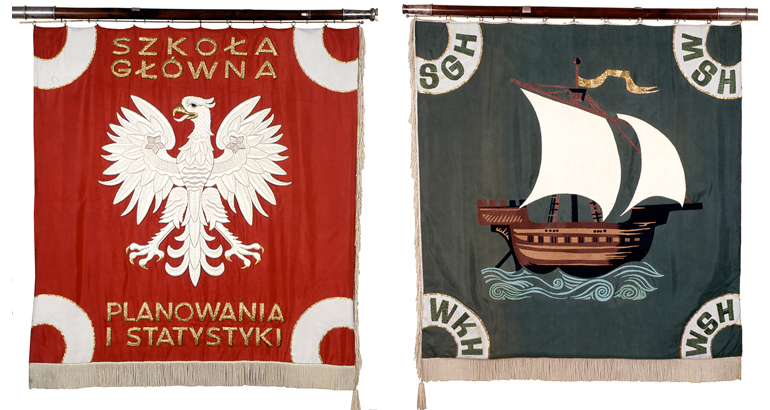
The Banner of Central School of Planning and Statistics (obverse and reverse).
Admission quotas were gradually increased. From 1949 to 1955, the number of students rose up from around 2100 to more than 5100. Many student organisations were abolished – students could associate in the Union of Polish Youth, Polish Students’ Union, Academic Students Association and self-help study groups.
The organisation and curricula of SGPiS followed solutions implemented at Soviet universities. Faculties emerged which reflected the industry composition of the economy and which offered narrow and specialist career preparation. The curriculum was designed by the Ministry of Higher Education and it was adapted to the needs of a state following the principles of the centrally planned economy.
The level of teaching and, above all, the directions of scientific research carried out at SGPiS were affected by a campaign undertaken in 1949 to verify and reshuffle academic staff. Edward Lipinski, Aleksei Wakar and Jan Drewnowski were removed from teaching. They were also prevented from continuing their previous research work. Edward Lipiński, who could no longer lecture on business cycle theory and economics, took up studies on the history of Polish economic thought. Some employees were removed from their jobs at the new university. Professors Kazimierz Kasperski and Julian Makowski, as well as the first post-war SGH Rector, prof. Jerzy Loth, were forced to retire. Prof. Edmund Dąbrowski and around twenty assistants were ousted from the university. Professors Dąbrowski and Loth came back to SGPiS in the late 1950s and they educated young people and carried out their research for many years to come. Aleksy Wakar, SGH Rector from 1946 to 1947, suffered a tragic fate. In 1950, he was deprived of a right to lecture, and in the summer of 1952, he was arrested and handed over to the Soviet authorities. He came back to Poland after spending almost three years in a Soviet forced labour camp. Until his death in 1966, he was the head of Political Economy Department and he nurtured numerous university professors-to-be.
1906–1908 – August Zieliński’s Private Courses of Commerce for Men
1908–1915 – August Zieliński's Higher Commerce Courses
1915–1933 – Higher School of Commerce in Warsaw
1933–1940 – Warsaw School of Economics
1940–1941 – Economic Courses
1941–1942 – Municipal School of Economics
1942–1943 – Municipal School of Economics of II degree
1943–1944 – Municipal Courses of Commerce
1944–1945 – Academic Courses in Częstochowa
1945–1949 – Warsaw School of Economics
1949–1991 – Central School of Planning and Statistics in Warsaw
od 1991 – SGH Warsaw School of Economics
CHANGES TO THE UNIVERSITY POLICY OVER SUBSEQUENT YEARS
The early 1950s went down in history as a time of political and ideological pressure. Things started to change slowly later on in the decade – opportunities for research and Western Europe scholarship became more available. The Institute of Social Economy was reactivated as part of SGPiS. Along with an Economic and Social Faculty which was established in 1968 it carried out research on the social effects of management.
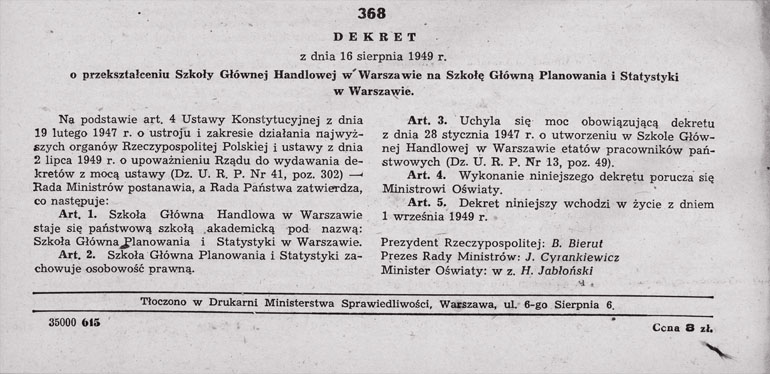
The decree on transforming SGH Warsaw School of Economics into Central School of Planning and Statistics in Warsaw
Interdisciplinary, interdepartmental and even interuniversity research began. Examples of such efforts included the Institute of the Fundamental Problems of Commerce (at the initiative of Aleksy Wakat) and the Interuniversity Unit of Developing Countries’ Economies established together with the University of Warsaw. The unit laid the foundations for an Institute of Developing Countries’ Economies. At SGPiS, foreign students came to be admitted to post-graduate studies. In 1962, the first Higher Course of Economic Planning for Foreigners was launched in English and Polish. The course was completed by a few hundred students, mainly economists, economic activists and planners from less economically developed countries.
In an effort to perpetuate tradition, a celebration of the university’s 60th anniversary was held in 1966. Many auditoriums and lecture rooms were named after the school's prominent professors. Ceremonial inauguration of this jubilee was attended by numerous guests on 13 October 1966. On that day, for the first time in the university's history, the Senate appeared in togas, with chains and rector's insignia.
The events of March 1968 were a particularly difficult time for our country. Student protests against the policy of the state authorities held at SGPiS were rather calm as compared with other Warsaw universities. However, in the spirit of non-tolerance, numerous lecturers were dismissed. Prof. Michał Kalecki, a prominent economist, left the university.
In June 1970, the Senate awarded an honorary doctoral degree (honoris causa doctorate) to Edward Lipiński, who aired critical views on the state authorities. A tradition of awarding the honorary degree emerged at the Main School of Planning and Statistics in the mid-1960s, during the term of prof. Wiesław Sadowski as the university’s rector. It was Leonid Witaljewicz Kantorowicz, a Soviet mathematician and economist who first received the honourable degree of honoris causa doctorate of SGPiS in 1968. A few years later, in 1975, together with Tjalling Koopmans, he received a Nobel Prize in Economics for a contribution to the theory of the optimal allocation of resources. Professor Kantorowicz collected the honoris causa doctor’s diploma only in 1976.
A plaque in memory of August Zieliński, the founder of the Higher Courses in Commerce, unveiled in 1949 in Building A when the reconstruction of the building that burned down in 1944, was completed.
A plaque in memory of the professors of Leopold Kronenberg School of Commerce, unveiled in 1949 in Building A when the reconstruction of the building that burned down in 1944.
In the 1970s, a Poland-wide system of scientific research control was established, with research institutes as the basis. Next to the then-existing institutes, new university-wide scientific and research institutes were formed at SGPiS: Institute for the Functioning of the National Economy, Economic Development, Cybernetics and Management, and the World Economy.
The number of students largely increased and it surpassed 10 thousand. Some students used the consultation desks in Białystok and Olsztyn.
In 1980, the post-August changes gave rise to the university’s “Solidarity” union and the Independent Students’ Association. The events countrywide were reflected in a three-week strike at SGPiS in the autumn of 1981. The introduction of martial law entailed staff reshuffle on the level of faculties and restriction of the university’s independence.

International student seminar. His Magnificence Rector prof. Wiesław Sadowski delivering a speech.
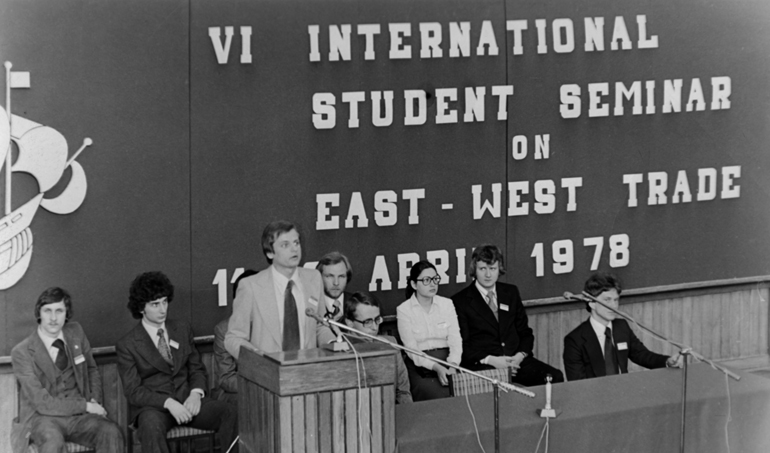
International student seminar, April 1978. Krzyszof Kalicki delivering a speech.
The 1980s ushered in a significant improvement in the housing conditions of SGPiS. In 1985, Building F was put into use and its architecture was definitely far from other buildings designed by architect Jan Witkiewicz-Koszczyc. In addition, the university managed to obtain a building in Wiśniowa Street which housed the then Economic and Social Faculty, a pavilion was constructed in Batorego Street to house a canteen, a building in Mokotowskie Field - a student club - and the third floor in the Main Building was adapted for administration purposes.
At SGPiS, four faculties were initially established: Faculty of Industry Planning, Statistics, Financial Planning, Commerce Planning. Later on, a Faculty of Agricultural Economics was formed, followed by the Faculties of Agriculture and Industry being merged into the Faculty of Industrial Economics while the Faculties of Statistics and Finance were merged into one Faculty of Finance and Statistics. From 1954 to 1959, also a Faculty of General Economics existed. From the School of Foreign Service, the Faculty of Foreign Trade was transferred to SGPiS (the academic year of 1954/1955) and a new Faculty of Economics and Social Sciences was established (the academic year of 1968/1969). In the early 1980s, a Cooperative and Economic Faculty was established in Rzeszów (it started its activities in the academic year of 1984/1985).
In March 1990, the Senate decided to abolish faculties and establish a collegial structure, and to change the curricula. In addition, a decision was made on 4 July 1990 to revert to the university’s old name – Warsaw School of Economics. On 5 November 1990, Aleksander Müller was elected university rector. A new stage in the history of the university began.
dr BARBARA TRZCIŃSKA, Department of Economic Geography, Collegium of Business Administration, SGH

